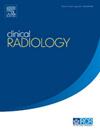Characterization of MRI findings by pTERT mutation status and the prognostic significance in GBM patients with recurrent lesions
IF 2.1
3区 医学
Q2 RADIOLOGY, NUCLEAR MEDICINE & MEDICAL IMAGING
引用次数: 0
Abstract
Aim
To investigate the MRI characteristics of recurrent glioblastoma (GBM) in relation to telomerase reverse transcriptase-promoter (pTERT) mutation status and their prognostic significance.
Materials and Methods
A retrospective analysis was conducted on 80 patients with primary IDH wild-type GBM. MRI features, including conventional and functional imaging, were compared between pTERT mutant and wild-type groups. Cox regression and receiver operating characteristic (ROC) analyses were performed to evaluate survival outcomes and predictive models.
Results
Compared to patients with wild-type pTERT (n = 24), those with mutant pTERT (n = 56) were older (p = 0.008) and had shorter overall survival (OS) (p = 0.003). They also exhibited a higher incidence of massive-like enhancement (p = 0.036) and new subependymal enhancement (p = 0.034), lower relative apparent diffusion coefficient (rADC) (p = 0.006), and higher relative cerebral blood volume (rCBV) (p = 0.048) and choline/N-acetyl aspartate ratio (p = 0.033). Multivariate analysis identified new subependymal enhancement (HR = 2.348, p = 0.018) and massive-like enhancement (HR = 2.348, p = 0.018) as independent risk factors for shorter OS. The areas under the ROC curve (AUCs) for predicting poor OS using pTERT mutation status, conventional MRI, and combination models were 0.700, 0.695, and 0.764, respectively. Among the 31 patients with available functional MRI data, the AUCs for prediction using functional MRI, conventional MRI + pTERT mutation status, and the combination model were 0.783, 0.710, and 0.888, respectively.
Conclusions
MRI features, particularly subependymal and massive-like enhancements, along with pTERT mutation status, serve as valuable prognostic markers for survival outcomes in recurrent GBM patients. The combination model incorporating MRI characteristics and genetic status enhances predictive accuracy.
复发性GBM患者pTERT突变状态的MRI表现特征及预后意义
目的探讨复发性胶质母细胞瘤(GBM) MRI特征与端粒酶逆转录启动子(pTERT)突变状态的关系及其预后意义。材料与方法对80例原发性IDH野生型GBM患者进行回顾性分析。比较pTERT突变型组和野生型组的MRI特征,包括常规和功能成像。采用Cox回归和受试者工作特征(ROC)分析来评估生存结局和预测模型。结果与野生型pTERT患者(n = 24)相比,突变型pTERT患者(n = 56)年龄更大(p = 0.008),总生存期(OS)更短(p = 0.003)。他们也表现出较高的块状强化发生率(p = 0.036)和新的室管膜下强化发生率(p = 0.034),较低的相对表观扩散系数(rADC) (p = 0.006),较高的相对脑血容量(rCBV) (p = 0.048)和胆碱/ n -乙酰天冬氨酸比值(p = 0.033)。多因素分析发现新的室管膜下增强(HR = 2.348, p = 0.018)和块状增强(HR = 2.348, p = 0.018)是缩短OS的独立危险因素。使用pTERT突变状态、常规MRI和联合模型预测不良OS的ROC曲线下面积(auc)分别为0.700、0.695和0.764。在31例可获得功能MRI数据的患者中,使用功能MRI、常规MRI + pTERT突变状态和联合模型预测的auc分别为0.783、0.710和0.888。结论smri特征,特别是室管膜下和肿块样增强,以及pTERT突变状态,是复发性GBM患者生存结果的有价值的预后指标。结合MRI特征和遗传状态的组合模型提高了预测的准确性。
本文章由计算机程序翻译,如有差异,请以英文原文为准。
求助全文
约1分钟内获得全文
求助全文
来源期刊

Clinical radiology
医学-核医学
CiteScore
4.70
自引率
3.80%
发文量
528
审稿时长
76 days
期刊介绍:
Clinical Radiology is published by Elsevier on behalf of The Royal College of Radiologists. Clinical Radiology is an International Journal bringing you original research, editorials and review articles on all aspects of diagnostic imaging, including:
• Computed tomography
• Magnetic resonance imaging
• Ultrasonography
• Digital radiology
• Interventional radiology
• Radiography
• Nuclear medicine
Papers on radiological protection, quality assurance, audit in radiology and matters relating to radiological training and education are also included. In addition, each issue contains correspondence, book reviews and notices of forthcoming events.
 求助内容:
求助内容: 应助结果提醒方式:
应助结果提醒方式:


